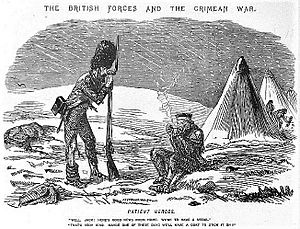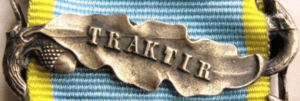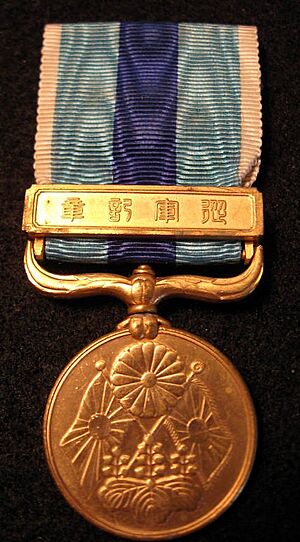Crimea Medal facts for kids
Quick facts for kids Crimea Medal |
|
|---|---|

Obverse and reverse of the medal.
|
|
| Type | Campaign medal |
| Eligibility | British forces. |
| Awarded for | Campaign service. |
| Campaign(s) | Crimean War. |
| Description | Silver disc, 36mm diameter. |
| Clasps | |
| Statistics | |
| Established | 15 December 1854 |
| Related | Turkish Crimea Medal Baltic Medal |
| Ribbon: 27mm, pale blue with yellow edges. | |
The Crimea Medal was a special award given to soldiers and sailors. It was created on December 15, 1854. This medal was for British troops who fought in the Crimean War from 1854 to 1856. This war was against Russia.
Soldiers usually received this medal along with the British version of the Turkish Crimea Medal. However, one shipment of Turkish medals was lost at sea. Because of this, some troops got a Sardinian version instead.
Contents
What Does the Medal Look Like?
The Crimea Medal is a silver circle, about 36 millimeters wide. On the front, it shows Queen Victoria's head. Below her, it says "VICTORIA REGINA" (which means Queen Victoria) and the year "1854".
On the back, there is a picture of a Roman warrior. He is about to get a laurel crown from a flying figure of victory. The word "CRIMEA" is written on the left side.
Unique Features
This medal is famous for its fancy clasps. Clasps are metal bars added to the ribbon. Each clasp looks like an oak leaf with acorns at both ends. This design is very special and not found on other British medals.
The part that connects the medal to its ribbon is also unique. It's a fancy, swiveling design. The ribbon itself is 27 millimeters wide. It is pale blue with yellow edges.
Most of these medals were given out without names on them. But soldiers could send them back to have their names added for free. The names were stamped on the edge of the medal. Some people also had their medals privately engraved.
Special Clasps and Who Got Them
Five different clasps were created for the Crimea Medal. Each clasp represented a major battle or event.
- Alma – This clasp was for the battle on September 20, 1854.
- Balaklava – This was for the battle on October 25, 1854.
- Inkerman – This clasp was for the battle on November 5, 1854.
- Sebastopol – This was for the long siege. It lasted from September 11, 1854, to September 9, 1855. If a soldier received the Balaklava or Inkerman clasp, they also got this one.
- Azoff – This clasp was for a naval trip. It happened in the Sea of Azoff from May 25 to September 22, 1855. Only Royal Navy sailors received this clasp.
The Alma and Inkerman clasps were approved in December 1854. The Balaklava clasp was added in February 1855. Sebastopol was approved in October 1855, and Azoff in May 1856. No one received more than four clasps.
If a soldier died during the war, their family members received the medal. Troops who arrived in Crimea after September 9, 1855, did not get the medal. This was unless they fought the enemy after that date.
French and Turkish Clasps
The Crimea Medal was also given to some Turkish and French soldiers. Sometimes, French soldiers added their own unofficial clasps. These included:
- Tchernaia – For a battle on August 16, 1855.
- Traktir – Another name for the Tchernaia clasp.
- Mer d'Azoff – For French Navy missions in the Sea of Azoff. These were from May 25 to November 22, 1855.
- Malakof – For a battle on September 8, 1855.
How the Medal Inspired Others
The special design of the Crimea Medal influenced other awards.
The part that holds the medal (the suspender) and the clasp design were used again. For example, they inspired the 2020 Australian Cadet Service Medal. This medal is given to Australian Defence Force cadets.
Many Japanese military medals from the late 1800s to mid-1900s also copied the Crimea Medal's design. Some of these medals include:
- 1874 Formosa Expedition War Medal
- 1904-05 Russo-Japanese War Medal
- And several others given for service or special events.
See also

That’s very kind. Maybe one of these days we'll have a coat to stick it on!
- Category:Recipients of the Crimea Medal
- Baltic Medal
- Turkish Crimean War medal
- Sardinian Crimea Medal




